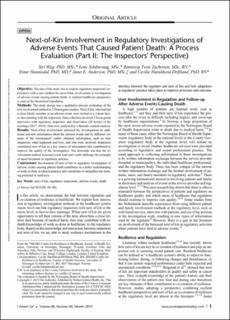| dc.contributor.author | Wiig, Siri | |
| dc.contributor.author | Schibevaag, Lene | |
| dc.contributor.author | Tvete Zachrisen, Rannveig | |
| dc.contributor.author | Hannisdal, Einar | |
| dc.contributor.author | Haraldseid-Driftland, Cecilie | |
| dc.contributor.author | Anderson, Janet | |
| dc.date.accessioned | 2021-02-22T08:16:29Z | |
| dc.date.available | 2021-02-22T08:16:29Z | |
| dc.date.created | 2019-10-29T11:27:53Z | |
| dc.date.issued | 2019-10 | |
| dc.identifier.citation | Wiig, S., Schibevaag, L., Tvete Zachrisen, R. (2019) Next-of-Kin Involvement in Regulatory Investigations of Adverse Events That Caused Patient Death: A Process Evaluation (Part II: The Inspectors' Perspective). Journal of patient safety, doi: 10.1097/PTS.0000000000000634 | en_US |
| dc.identifier.issn | 1549-8417 | |
| dc.identifier.uri | https://hdl.handle.net/11250/2729356 | |
| dc.description.abstract | Objective
The aim of the study was to explore regulatory inspectors' experiences with a new method for next-of-kin involvement in investigation of adverse events causing patient death. A resilient healthcare perspective is used as the theoretical foundation.
Methods
The study design was a qualitative process evaluation of the new involvement method in 2 Norwegian counties. Next of kin, who had lost a close family member in an adverse event, were invited to a 2-hour face-to-face meeting with the inspectors. Data collection involved 3 focus group interviews with regulatory inspectors and observation (20 hours) of the meetings (2017–2018). Data were analyzed by a thematic content analysis.
Results
Next-of-kin involvement informed the investigations by additional and new information about the adverse events and by different versions of the investigators' earlier obtained information, such as time sequences, what happened and how, and who were involved. Inspectors considered next of kin as a key source of information that contributed to improve the quality of the investigation. The downside was that the involvement method increased work load and could challenge the principle of equal treatment in regulatory practice.
Conclusions
Involvement of next of kin in regulatory investigation of adverse events causing patient death contributes to a better understanding of work as done in clinical practice and contributes to strengthen the learning potential in resilience. | en_US |
| dc.language.iso | eng | en_US |
| dc.publisher | Wolters Kluwer Health, Inc. | en_US |
| dc.rights | Attribution-NonCommercial-NoDerivatives 4.0 Internasjonal | * |
| dc.rights.uri | http://creativecommons.org/licenses/by-nc-nd/4.0/deed.no | * |
| dc.subject | pasientsikkerhet | en_US |
| dc.subject | pårørende | en_US |
| dc.title | Next-of-Kin Involvement in Regulatory Investigations of Adverse Events That Caused Patient Death: A Process Evaluation (Part II: The Inspectors' Perspective) | en_US |
| dc.type | Peer reviewed | en_US |
| dc.type | Journal article | en_US |
| dc.description.version | publishedVersion | en_US |
| dc.rights.holder | © 2019 The Author(s) | en_US |
| dc.subject.nsi | VDP::Medisinske Fag: 700::Helsefag: 800 | en_US |
| dc.source.pagenumber | 6 | en_US |
| dc.source.journal | Journal of patient safety | en_US |
| dc.identifier.doi | 10.1097/PTS.0000000000000634 | |
| dc.identifier.cristin | 1741609 | |
| dc.relation.project | Universitetet i Stavanger: 5091 | en_US |
| cristin.ispublished | true | |
| cristin.fulltext | original | |
| cristin.qualitycode | 1 | |

